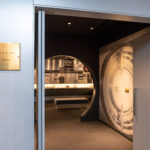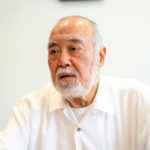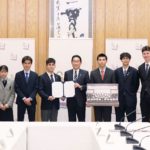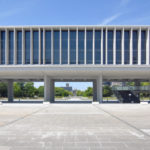Column: Hiroshima Carp: The Citizens’ Baseball Team, and a Guidepost to Reconstruction
Introduction
What symbolizes Hiroshima? The people of Hiroshima tend to think of the world heritage sites of the A-bomb Dome and Miyajima (Itsukushima Shinto Shrine), oysters and okonomiyaki, and the three professional organizations: the Hiroshima Symphony Orchestra, the Sanfrecce Hiroshima Football Club, and of course the Hiroshima Carp baseball team.1) Among the three, the Hiroshima Carp (officially the “Hiroshima Toyo Carp”) has the longest history.
1 The Citizens’ Baseball Team
Since before the war, high school baseball teams in Hiroshima were among the best in Japan, such as the Hiroshima Prefectural Hiroshima Commercial High School team. In the past, they have won first place at national high school baseball tournaments. Baseball has long been a popular sport among the people in Hiroshima. When the professional baseball games restarted after the war, the baseball stadium in Hiroshima was packed with fans; and when professional baseball teams were reorganized into two leagues in 1950, a team founded in Hiroshima applied to join the league. On January 15, a ceremony was held to celebrate the inauguration of the Hiroshima Carp, and their first game was held on March 10. The team was named the Hiroshima “Carp” because many koi (carp) were caught in the Ota River in Hiroshima, and carp are believed to bring good fortune, and symbolize success. Another reason is that Hiroshima Castle, built by Terumoto Mori, was nicknamed “Carp Castle.”2)
Unlike other baseball teams, the Carp did not have a parent company. The baseball team was founded with investments by the City of Hiroshima, Hiroshima Prefecture, and other local municipalities. The citizens of the City of Hiroshima and of Hiroshima Prefecture also became shareholders and raised funds to support the team. The Hiroshima Carp had serious financial difficulties from the start, but the people formed supporters’ groups at their workplaces and donated money in the big sake cask (Hiroshima is home to many sake brewers) placed in front of the stadium to save the team from its financial predicaments.3) This is why the Hiroshima Carp is referred to as the “citizens’ baseball team.”
2 Burdened with the Shadows of War
Of the Carp players active in the early years, there were many from Hiroshima, who had the “shadow of war”. One such player, Kenshi Zenimura (a Japanese American from Hawaii), joined the team together with his elder brother Kenzo in 1953. During the Pacific War he suffered the bitter experience of being interned with his family at a Japanese internment camp in Arizona. When he joined the team, he received a passionate welcome from the people of Hiroshima (his father’s hometown). He became famous as an outfielder and for his base running skills. In July 1954, he participated in the All-Star Games at the recommendation of the manger.4)
The Carp also had players who were survivors of the atomic bombing. One of them was Takashi Harada, who was exposed to the atomic bombing at the age of 13 while working as a mobilized student in Minami-machi. His face and hands and feet were burned. The clothes that he was wearing at that time have been preserved at the Hiroshima Peace Memorial Museum.5)
3 As Goodwill Ambassadors
The Hiroshima Carp’s first overseas tour was to the Philippines. It was January 1954, the fourth year since the team was created. The Philippines had been occupied by the Japanese military during the Pacific War. It had suffered enormous damages, and there was a strong anti-Japanese sentiment. In the previous year, in 1953, over 100 Japanese war criminals in a prison on the outskirts of Manila (the majority of them were on death row) were pardoned and released by the president of the Philippines. Although there were signs of a cordial mood, the team toured to the Philippines at a time when anti-Japanese sentiments were still strong among the people in the Philippines.6)
This tour was made possible at Takizo Matsumoto’s request to the Philippines. Mr. Matsumoto used to be a member of the baseball team at Koryo High School in Hiroshima, and he had also taught as a professor at the University of the Philippines before the war.7) The Carp played a total of 12 games at the Rizal Memorial Stadium in Manila from January 16 to 31, 1954, with the Cap winning 11 games. Almost every day, local newspapers reported the games with the Carp from Hiroshima, an A-bombed city. The members of the Carp were described as “Japan’s goodwill ambassadors” by a local newspaper and behaved with the composure of professional players in front of the people of the Philippines at the games.8) President Ramon Magsaysay and all the people who met the Carp players welcomed them warmly and gave the players good impressions.9) After their last game on January 31 with the Canlubang Sugar Barons, the Philippine spectators gave a warm round of applause to the Carp players, who waved their caps to say goodbye.
4 Symbol of Reconstruction
The Hiroshima Carp, which came about when there were still many scars of the atomic bombing, 10) became a symbol of Hiroshima’s reconstruction. The Hiroshima Municipal Baseball Stadium was completed in July 1957, facing the A-bomb Dome across the street. This was the first stadium in Hiroshima equipped for night games, and the first night game was held on July 24.11) However, the team ranked low in the league standing for a long time. It remained in class-B for 18 consecutive years after the team was established. However, the Carp were supported by passionate fans. Kenzaburo Oe, a famous writer, visited Hiroshima in the early 1960s and wrote in Hiroshima Notes about a taxi driver who enthusiastically told him about the Carp game of the night before. 12)
Joe Lutz, who had been a Major League coach, became manager of the Hiroshima Carp in October 1974. He was the first American manager of a Japanese professional baseball team. He changed the color of the caps and helmets to red, a “fighting color.” In 1975 the Carp, the “red helmets,” created a great sensation in the pennant race. On October 15, the team won the game against the Tokyo Giants and won its first Central League pennant. Twenty-six years had passed since the team was founded. This was when many years of efforts were at last rewarded.
The Hiroshima Carp were founded in the wake of the bombing and grew as Hiroshima rebuilt. It became a pioneer for professional sport teams deeply rooted in their local communities. In order to express the team’s wish for peace, a “peace night game” was introduced in 2008. This is a game held in Hiroshima in the pennant race closest to August 6. This represents the efforts of the Carp to pass on the experience of an atomic bombing to the next generation.
(Hitoshi Nagai)
Notes
1. Hiroshima Prefecture. “Results of Fiscal Year 2007 1st Hiroshima Prefectural Government Monitoring Survey”. http://www.pref.hiroshima.lg.jp/site/kenseiiken/1184907357815.html (accessed January 16, 2014)
2. Chugoku Shimbun (Ed.). Hiroshima Toyo Carp Kyudanshi (History of the Hiroshima Toyo Carp Baseball Team). Hiroshima Toyo Carp, 1976: p. 173.
3. Nishimoto, Megumu. Hiroshima Carp no Mukashibanashi, Urabanashi (Old Tales and the Inside Story of the Hiroshima Toyo Carp). Talk Shuppansha, 2008: pp. 84-91.
4. Bill Staples, Jr., Kenichi Zenimura: Japanese American Baseball Pioneer. North Carolina: McFarland & Company, Inc. Publishers, 2011: pp. 116, 197-200; Asahi Shimbun, June 30, 1954 edition.
5. Nishimoto, op. cit., pp. 198-205. Jigoku no Kioku o Furikiru yo ni Yakyu ni Nomerikonda Hibi” (Daily Devotion to Baseball to Shake Off Memories of Hell). Asahi Graph No. 2930, August 17, 1979: p. 23. “Peace Database”. (http://a-bombdb.pcf.city.hiroshima.jp/pdbj/detail.do?data_id=52597) (accessed January 23, 2014).
6. Shiraishi, Katsumi. Sebango Hachi wa Gyaku Single (Player 8 Makes a Backhand Catch). Baseball Magazine Sha, 1989: p. 196.
7. Ibid. pp. 197-199.
8. Manila Bulletin, Jan. 23, and 30, 1954; Chugoku Shimbun, op. cit., p. 327.
9. Yamakawa, Takenori. “Nippi Shinzen no Tabi–Firippin Kiko” (A Journey of Friendship between the Philippines and Japan – An Account of Trip to the Philippines). Baseball Magazine, Vol. 9, No. 3, March 1954: p. 73.
10. AccordingtotherecollectionsofMs.HoriuchiinChugokuShimbun,op.cit.,p.348.
11. The Hiroshima Municipal Baseball Stadium was closed in September 2010 due to the aging structure. (The Carp’s last game at the stadium was held on September 28, 2008). The stadium was dismantled in 2012, with a portion of the right-field stands remaining. The new municipal baseball stadium, Mazda Zoom-Zoom Stadium Hiroshima, commonly called “Mazda Stadium,” was completed near Hiroshima Station in March 2009, and has been the Carp home-field since that year’s baseball season.
12. Oe, Kenzaburo. Hiroshima Noto (Hiroshima Notes). Iwanami Shinsho, 1965: p. 46.
Tags associated with this article








